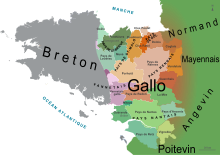Gallo is a regional language of France. It is not as commonly spoken as it once was, as the standard form of French now predominates. Gallo is classified as one of the Oïl languages . Langue d’oïl (in the singular), Oïl languages (in the plural) designate the ancient northern Gallo-Romance languages as well as their modern-day descendants. They share many linguistic features, a prominent one being the word oïl for yes. (Oc was and still is the southern word for yes, hence the langue d’oc or Occitan languages). The most widely spoken modern Oïl language is French (oïl was pronounced (o.il) or (o.l), which has become (wi), in modern French (oui).
Gallo was originally spoken in the Marches of Neustria, visited by Columbanus from Bangor in his travels, which now corresponds to the border lands of Brittany and Normandy and its former heart in Le Mans, Maine. Gallo was the shared spoken language of the leaders of the Norman Conquest of England and Wales, then Scotland and Ireland, most of whom originated in Upper Brittany and Lower Normandy. Thus Gallo was a vehicle for the subsequent transformation (“Gallicisation”) of English, through Anglo-Norman. Brought to Ulster by John de Courcy, it is a former language of Carrickfergus, and Gallo elements can be traced in its early documenttation.
Gallo continued as the language of Upper Brittany, Maine and some neighbouring portions of Normandy until the introduction of universal education across France, but today Gallo is spoken by only a small minority of the population, having been largely superseded by standard French. As an Oïl language, Gallo forms part of a language continuum which includes Norman, Picard and Poitevin, among others. One of the features that distinguishes it from Norman is the absence of Old Norse influence. There is some limited mutual intelligilility with adjacent varieties of the Norman language along the linguistic frontier and with Guernésiais and Jèrriais spoken in Guernsey and Jersey. In the west, the vocabulary of Gallo has been influenced by contact with Breton, the Brittonic tongue traditionally spoken in the western territory of Brittany, but remains overwhelmingly Latinate. The influence of Breton decreases eastwards across Gallo-speaking territory. During their migration to Brittany, Britons also occupied the Lenur islands (the former name of the Channel Islands) including Sarnia or Lisia (Guernsey) and Angia (Jersey). Travelling from the King of Gwent, Saint Sampson, later the abbot of Doll in Brittany, is credited with the introduction of Christianity to the islands.
Many Bretons who came in the Norman Conquest spoke Breton rather than Gallo. The prominent Stuart family, including William of Orange and his wife Mary Stuart were both descended from the Breton nobleman Alan, son of Flaald, who came to England with William the Conqueror. So that Breton and Gallo are very much part of our linguistic heritage. Jersey (officially the Bailiwick of Jersey (French: Bailliage de Jersey; Jèrriais : Bailliage dé Jèrri), is a Crown Dependency of the United Kingdom. located near the coast of Normandy, France. Jersey was part of the Duchy of Normandy, whose dukes went on to become kings of England from 1066. After Normandy was lost by the kings of England in the 13th century, and the ducal title surrendered to France, Jersey, Guernsey and the other Channel Islands remained attached to the English crown.
One bailiwick consists of the island of Jersey, the largest of the Channel Islands, along with surrounding uninhabited islands and rocks collectively named Les Dirouilles, Les Écréhous, Les Minquiers, Les Pierres de Lecq, and other reefs. The other bailiwick (French: Bailliage de Guernesey) is made up of ten parishes on the island of Guernsey, three other inhabited islands (Herm, Jethou and Lihou), and many small islets and rocks. Although the bailiwicks of Jersey and Guernsey are often referred to collectively as the Channel Islands, the “Channel Islands” are not a constitutional or political unit. Jersey has a separate relationship to the Crown from the other Crown dependencies of Guernsey and the Isle of Man, although all are held by the monarch of the United Kingdom. Jersey and Guernsey are self-governing parliamentary democracies under a constitutional monarchy, with their own financial, legal and judicial systems, and the power of self-determination. The Lieutenant Governor on both the islands of Jersey and Guernsey is the personal representative of the Queen.
Jersey and Guernsey are not part of the United Kingdom, and have an international identity separate from that of the UK, but the UK is constitutionally responsible for their defence.The definition of United Kingdom in the British Nationality Act 1981 is interpreted as including the UK and the Islands together. The European Commission have confirmed in a written reply to the European Parliament in 2003 that Jersey is within the Union as a European Territory for whose external relationships the UK is responsible. Jersey is not fully part of the European Union but has a special relationship with it, notably being treated as within the European Community for the purposes of free trade in goods.
